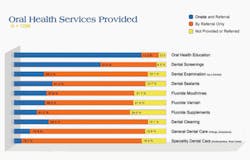by Christine Nathe, RDH, MS
[email protected]
One of the most important roles of dental hygienists is to communicate. As dental hygienists, we must communicate our knowledge and skills to others, and we must be able to listen and work with others. This is why it's so important to know about groups and organizations that have similar goals, and to develop relationships with those groups by communicating.
Figure 1: The source of this chart is Strozer J., Juszczak L., and Ammerman A. (2010). 2007-2008 National School-Based Health Care Census. Washington, DC: National Assembly on School-Based Health Care.
The mission of one such organization, the National Assembly on School-Based Health Care (NASBHC), is to improve the health of youth by advancing and advocating school-based health care. Specifically, NASBHC believes that:
Children and adolescents need high quality, accessible, culturally competent, comprehensive health care.
The school setting is a sensible and appropriate place to deliver health care because it is where students are.
Ideally, the full scope of services is provided directly in a school-based health center (SBHC). Additional resources and the needs of the community may dictate alternative models.
SBHCs reduce health inequities and improve health outcomes for underserved youth.
SBHCs should be fairly reimbursed for the high-quality health services they provide.
Although dental hygiene was originally developed to deliver care in schools, for many years dental hygienists have worked outside of the school setting. However, during the past decade, more dental hygienists provided care in schools, so I know that this organization can be a real help to many when learning about this new setting.
NASBHC believes that students perform better when they show up for class healthy and ready to learn. SBHCs bring comprehensive health and mental health services to the school so that students can avoid health-related absences and receive support to succeed in the classroom. SBHCs may vary based on community needs and resources. SBHCs:
- Are located in schools or on school grounds
- Work cooperatively within a school to become an integral part of the school
- Provide a comprehensive range of services that meet the physical and behavioral health needs of the young people in the community
- Employ a multidisciplinary team of providers to care for the students: nurse practitioners, registered nurses, physician assistants, social workers, physicians, alcohol and drug counselors, and other health professionals
- Provide clinical services through a qualified health provider such as a hospital, health department, or medical practice
- Require parents to sign written consents for their children to receive the full scope of services provided at the SBHC
- Have an advisory board consisting of community representatives, parents, youth, and family organizations to provide planning and oversight
- May have alternative delivery models located off school grounds or may serve more than one school.
More than 1,900 SBHCs exist across the country to provide vulnerable children and adolescents with the comprehensive medical attention they need, and for many this includes dental care. A recent national census of SBHCs found that a majority provide oral health education (84%) and dental screenings (57%) to students. A smaller percentage of SBHCs provide dental examinations (20%), sealants (25%), and dental cleanings (23%). Oral trauma is prevalent in school-aged children, and SBHCs provide education on injury prevention. Another valuable service is nutritional counseling, since sugary foods and beverages contribute to poor oral health. See Figure 1 for more information about oral health services available at SBHCs.
"Poor oral health has been linked to a decrease in several markers of school success, including school attendance, concentration, school performance, and social relationships," said Linda Juszczak, executive director of NASBHC. "School-based health centers are an ideal location to deliver oral health services so that children and youth are healthy and ready to learn."
NASBHC has 25 state affiliates that can help SBHCs, and nationally this group could be a great resource for dental hygienists working to develop school-based programs or enhance existing programs. School-based dental care has the potential to be a great method to reach the dentally underserved.
Much of the information in this column can be found on NASBHC's Web site at www.nasbhc.org.
Christine Nathe, RDH, MS, is a professor and graduate program director at the University of New Mexico, Division of Dental Hygiene, in Albuquerque, N.M. She is also the author of "Dental Public Health Research" (www.prenhall.com/nathe), which is in its third edition with Prentice Hall. She can be reached at [email protected] or (505) 272-8147.
Past RDH Issues







